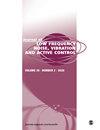基于非局部动力刚度模型的阶梯FGM纳米梁自由振动分析
IF 2.4
4区 工程技术
Q1 ACOUSTICS
Journal of Low Frequency Noise Vibration and Active Control
Pub Date : 2023-02-27
DOI:10.1177/14613484231160134
引用次数: 3
摘要
基于非局部弹性理论,提出了用于Winkler弹性地基上功能梯度材料(FGM)纳米梁自由振动分析的非局部动态刚度模型。NET模型考虑了长度尺度参数,可以捕捉到考虑非相邻原子和分子相互作用的纳米结构的小尺度效应。FGM纳米梁的材料特性在厚度上呈非线性变化。根据Timoshenko光束理论建立了纳米梁的模型,并利用Hamilton原理推导了其运动方程。DSM用于获得考虑中性轴位置的运动方程的精确解。提出的非局域DSM克服了悬臂梁基频的加筋现象,并与已发表的结果进行了比较验证。然后将该模型应用于阶梯式FGM纳米梁的自由振动研究。给出了材料分布、几何形状、非局部、弹性基础和边界条件对阶梯FGM纳米梁自由振动的影响。结果表明,该方法可以应用于更复杂的阶梯状纳米结构。本文章由计算机程序翻译,如有差异,请以英文原文为准。
Free vibration analysis of stepped FGM nanobeams using nonlocal dynamic stiffness model
A nonlocal Dynamic Stiffness Model (DSM) for free vibration analysis of Functionally Graded Material (FGM) nanobeams on a Winkler elastic foundation based on the Nonlocal Elastic Theory (NET) is proposed. The NET model considers the length scale parameter, which can capture the small scale effect of nanostructures considering the interactions of non-adjacent atoms and molecules. Material characteristics of FGM nanobeams are considered nonlinearly varying throughout the thickness. The nanobeams are modelled according to the Timoshenko beam theory and its equations of motion are derived using Hamilton’s principle. The DSM is used to obtain an exact solution of the equation of motion taking into account the neutral axis position. This nonlocal DSM proposed has overcome the stiffening phenomena of the cantilever beam fundamental frequency and validated by comparing the obtained results with published results. Afterwards the proposed model is applied to investigate free vibrations of stepped FGM nanobeams. Numerical results are presented to show the influence of the material distribution profile, geometry, nonlocal, elastic foundation and boundary conditions on the free vibration of stepped FGM nanobeams. It is shown that the proposed nonlocal DSM can be applied to more complex stepped nanostructures.
求助全文
通过发布文献求助,成功后即可免费获取论文全文。
去求助
来源期刊

Journal of Low Frequency Noise Vibration and Active Control
Engineering-Mechanical Engineering
CiteScore
4.90
自引率
4.30%
发文量
98
审稿时长
15 weeks
期刊介绍:
Journal of Low Frequency Noise, Vibration & Active Control is a peer-reviewed, open access journal, bringing together material which otherwise would be scattered. The journal is the cornerstone of the creation of a unified corpus of knowledge on the subject.
 求助内容:
求助内容: 应助结果提醒方式:
应助结果提醒方式:


